React fast, eliminate downtime with TPMS
Reliable road safety with 24/7 tyre control – Webfleet TPMS


React fast, eliminate downtime with TPMS
Reliable road safety with 24/7 tyre control – Webfleet TPMS


Webfleet Tyre Pressure Monitoring System (TPMS) checks your tyre pressure and temperature in real-time. With predictive tyre management, problems are detected before they lead to costly repairs or downtime. Whether you are transporting passengers or cargo – TPMS helps you ensure you get to your destination safely and on time.
Do you know?
The right Tyre Pressure Management System can positively impact your finances and safety in numerous ways.
20%
of commercial tyres on the road are significantly underinflated
+2.5%
increase in fuel consumption can be caused when a tyre is under-inflated by 20%*
90%
of tyre-related breakdowns are the result of slow leaks
Webfleet TPMS helps you
Detect issues before repairs or downtime are needed
Reduce breakdowns and service disruption
Enhance road safety
Save fuel
Optimise tyre mileage
Increase sustainability
Key features
Live view of your tyre pressure
See all your TPMS sensor-equipped vehicles and trailers with their latest tyre status1. Vehicle or trailer tyres identified with an issue are colour-coded to indicate the severity. A clear text description is also provided to explain the issue.
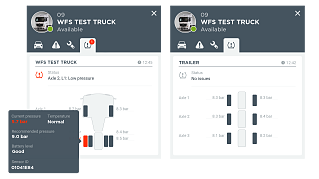

Real-time notifications
Receive a notification immediately when an abnormal tyre pressure or temperature issue is detected. Drivers can also choose to be notified when there’s a critical issue regarding the tyre pressure of the vehicle2.
Identify slow leaks
90% of tyre-related breakdowns are caused by slow leaks. Webfleet TPMS helps you spot slow pressure leaks before a driver possibly could. This reduces the risk of developing dangerously low pressure levels.

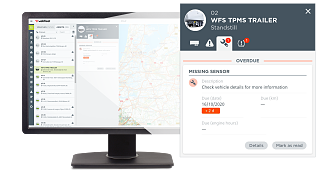
Whole-fleet TPMS solutions
Every fleet is unique, so we provide several methods for implementing the TPMS feature, with advanced solutions that cover a range of vehicle types and applications.
- Aftermarket TPMS: Uses LRX 100 and valve-mounted sensors
- Manufacturer TPMS: Uses OEM sensors
- LINK 350 for trailer only: Uses strap-mounted sensors
- OEM.connect for trailer only: No hardware required
Trailer support
By providing both truck and trailer with TPMS, fleet operators gain clear insights into tyre performance and vehicle safety. These systems track the last known position of a trailer and identify which truck it is connected to.
Truck TPMS and trailer TPMS offer data beyond location tracking. They also provide fleet managers with real-time updates on trailer and truck tyre pressure, temperature changes and air leakage. This encourages proactive maintenance to keep tyres in optimal condition, improving road safety and reducing the risk of breakdowns.
The EU’s Global Safety Regulation, effective July 2022, mandates that trailers and semi-trailers include tyre pressure monitoring systems. This regulation foregrounds legal compliance and underscores the importance of monitoring trailer tyre pressures for road safety. Using TPMS technology ensures operators meet these requirements and supports a more sustainable transport system.
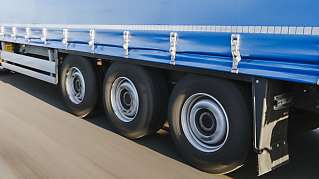
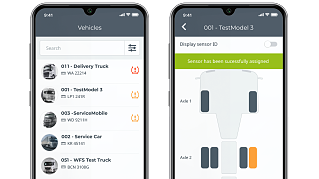
TPMS Tools app
Our dedicated Webfleet TPMS Tools app is designed to be used in your workshop or by your tyre dealer, simplifying the maintenance of the TPMS system.
More vehicle data
Webfleet TPMS is used in combination with a vehicle tracking device. You receive all the vehicle data you need, including location, odometer and more, on one interface3.

All you need to know about TPMS
About TPMS
What is a Tyre Pressure Monitoring System?
0
What is a Tyre Pressure Monitoring System?
0TPMS stands for Tyre Pressure Monitoring System. As the name suggests, TPMS is a system that monitors the air pressure in vehicle tyres. It helps drivers to maintain tyres at the correct pressure to enhance safety, prevent tyre damage and reduce fuel consumption.
When tyre pressure falls below the recommended level, the system activates a yellow alert symbol on the dashboard instrument panel, alerting drivers to act quickly to avoid potential risks.
Although TPMS allows for better tyre maintenance, it is not a replacement for regular tyre or vehicle checks. Drivers should still perform routine maintenance measures and inspect tyres.
How does TPMS work?
0
How does TPMS work?
0TPMS uses sensors to measure tyre pressure and temperature. These sensors are installed in each tyre and collect data continuously. The system sends this data to the vehicle’s computer or a separate display unit. The driver receives real-time updates, allowing them to monitor tyre conditions easily. It is not necessary to remove the TPMS sensor to inflate the tyre.
Are tyre pressure monitoring systems worth it?
0
Are tyre pressure monitoring systems worth it?
0As a proactive safety measure, predictive tyre management greatly reduces the chance of blowouts.
Having TPMS suited to your vehicle provides the following benefits.
- Enhanced safety: by continuously monitoring tyre pressure and temperature in real time, TPMS can provide a visual warning of low pressure whilst driving.
- Optimised fuel usage: by helping to confirm optimal tyre pressure, TPMS leads to fuel savings as properly inflated tyres use less fuel than under-inflated tyres.
- Reduced downtime: by identifying slow leaks and other tyre-related issues early on, TMPS encourages proactive maintenance. This helps prevent unexpected breakdowns and decreases vehicle downtime.
- Improved sustainability: efficient tyre management helps lower fuel consumption and reduce carbon emissions, supporting environmental sustainability goals.
Is TPMS a replacement for a vehicle check?
0
Is TPMS a replacement for a vehicle check?
0No. Checking tyres does not suffice as a vehicle check. To ensure safety on the road, all vehicle components should be checked frequently.
If you find paperwork tricky to keep track of, you can carry out the process digitally with the Webfleet Vehicle Check app. Drivers can simply walk around the vehicle and submit paperless checklists with a few finger taps. The information is easy to store and refer to again if needed.
What is normal tyre pressure?
0
What is normal tyre pressure?
0Tyre pressure depends on a variety of factors: vehicle type, axle load and type, tyre size and type, manufacturer specifications, road and climate conditions. Optimum tyre pressure is typically between six and nine bars, but you should always calculate the exact pressure required based on the specific conditions of your vehicle.
How much does TPMS maintenance cost?
0
How much does TPMS maintenance cost?
0The cost of TPMS maintenance depends on factors such as the type of sensor, vehicle model, and service provider. We recommend contacting your local service partner for exact pricing.
TPMS technology and functionality
How does TPMS know which tyre is which?
0
How does TPMS know which tyre is which?
0Each tyre is equipped with a Tyre Pressure Monitoring System sensor, which monitors tyre pressure and temperature in real time. This data is transmitted from the tyre sensors to your Webfleet account. Equipping both truck and trailer with TPMS gives you location visibility on the trailer, making it easy to know which truck your trailer is connected to.
How does the TPMS system signal a tyre issue?
0
How does the TPMS system signal a tyre issue?
0With Webfleet TPMS, you can view live readings of tyre pressure and temperature in the portal. Each vehicle or trailer tyre with an issue is colour coded to indicate the severity of the issue: amber for minor warnings, red for critical risks. A clear text description is also provided to explain the issue. You can receive alert notifications in Webfleet, the tools app, or the driver terminal.
How do I respond to seeing the warning light?
0
How do I respond to seeing the warning light?
0Alerts are triggered for tyre condition issues including:
- Tyre pressure too high or low
- Tyre temperature too high
- Dual wheel pressure difference
- Axle pressure difference
Upon receiving an alert, you need to take maintenance action.
When an issue that caused a notification is rectified, a back to normal
notification is generated. For example, if a tyre is re-inflated following a low pressure
notification, the message will appear.
Is it OK to drive with a TPMS warning light on?
0
Is it OK to drive with a TPMS warning light on?
0If the TPMS light is on, it is most likely not safe to drive. The best course of action is to stop the vehicle at the nearest place where stopping is permitted, inspect the tyres and, if necessary, call for assistance.
Tyre faults cause three main problems. Safety is the greatest issue — tyres must be kept at the correct pressure for optimum handling and braking distance.
The second issue is higher running costs. A tyre that is under-inflated by 20% causes a 2.5% increase in fuel consumption. This in turn has an environmental impact, causing increased CO2 emissions.
The third problem is increased vehicle downtime: tyre failure is the main cause of vehicle breakdowns.
Avoid these three problems with early tyre fault detection by TPMS.
TPMS types and system design
What are the different types of TPMS?
0
What are the different types of TPMS?
0There are two main types of tyre pressure monitoring: indirect TPMS and direct TPMS.
- Indirect TPMS
- Indirect TPMS does not estimate air pressure directly. It uses the vehicle's Anti-Lock Braking System (ABS) to detect changes in tyre rotation speed. When a tyre deflates, the diameter decreases, forcing it to rotate faster.
- Direct TPMS
- Direct TPMS uses pressure detectors installed inside each tyre. These sensors measure the actual air pressure in real time and send the data to the vehicle’s onboard computer.
Which type of TPMS does Webfleet use?
0
Which type of TPMS does Webfleet use?
0Webfleet uses direct TPMS, reading sensor data from within each tyre. Pressure levels and temperature readings are sent to the Webfleet cloud. The system then analyses this data to identify any issues and, if necessary, sends a notification via Webfleet. These real-time alerts mean that the fleet manager or driver can take action before costly repairs are needed.
TPMS sensors and installation
Are TPMS sensors required?
0
Are TPMS sensors required?
0For TPMS to monitor tyre pressure and temperature, sensors are required. The sensors transmit data in real time, giving you 24/7 tyre control.
The EU made TPMS sensors mandatory for passenger vehicles in November 2014. From 1 January 2025, UK law will classify vehicles with faulty TPMS sensors as MOT failures. This regulation emphasises the importance of fully functional TPMS sensors for safety and compliance.
Regular TPMS inspections are required to maintain system performance. Inspections should verify sensor function and faulty parts should be replaced.
How are TPMS sensors powered?
0
How are TPMS sensors powered?
0TPMS sensors work in combination with vehicle tracking devices. Seamlessly integrated, they provide you with location, odometer and other important vehicle data needed to keep your fleet safe and productive.
What is the life expectancy of a TPMS sensor?
0
What is the life expectancy of a TPMS sensor?
0The industry average for a TPMS sensor battery is around 3 years.
Does a tyre have to be removed to replace the TPMS sensor?
0
Does a tyre have to be removed to replace the TPMS sensor?
0It depends on the sensor type. Valve-mounted sensors do not tyre demounting as they are installed on the outside of the valve.
However, strap-mounted sensors offered with the LINK 350 solution do require tyre demounting because the sensors must be installed around the wheel.
Other monitoring systems, such as Manufacturer TPMS or OEM.connect, do not require tyre demounting either as these methods use OEM sensors and data that come pre-installed from the factory.
How Webfleet TPMS works
How Webfleet TPMS works
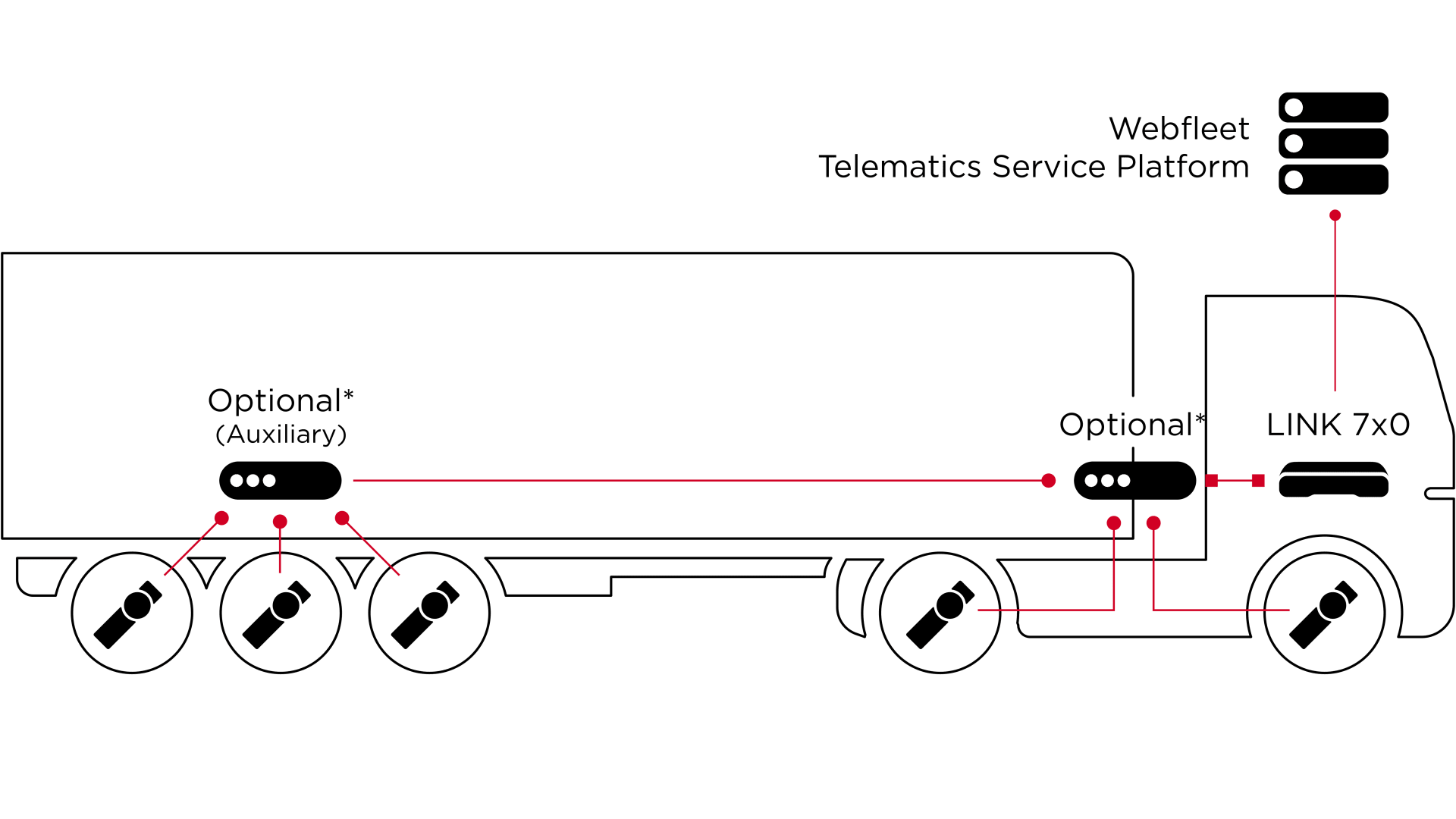
* LRX100 required for vehicles do not conform UN ECE R141.
* For only trailer solution does not require receivers.
* Manufacturer TPMS does not require receivers.

Advanced tyre technology: What does it mean for your fleet?

Our latest eBook deep dives into the new solutions, designs and materials optimising tyre performance and the potential impact on the sustainability, safety and cost effectiveness of your fleet.
Return on investment in six to nine months
Want to prevent tyre incidents from happening, keep your drivers safe and reduce your tyre costs? Request a call back from one of our experts and find out how Webfleet TPMS helps you achieve it all.






* Source: Bridgestone (based on 20% under-inflation, the impact may vary depending on the tyre specifications)
1 Webfleet TPMS supports rigid bodied trucks, tractor-trailer combinations, buses and coaches. TPMS functionality is currently only supported for trailers when the trailer is used together with a towing tractor fitted with Webfleet TPMS.
2 In-cab driver alerts available for PRO 2020/7350/8375/8475.
3 Webfleet TPMS is a service in addition to a Webfleet subscription. It is used in combination with a LINK 710/LINK 740 vehicle tracking device for data connectivity.
Your consent is required
In this section, external content is being embedded from .
To display the content, your consent is required for the following cookie categories:
- Targeted Advertising
- Analytics & Personalization
- Essential
For further details, please refer to our privacy policy. If you are interested in how ###vendor_name### processes your data, please visit their privacy policy.











